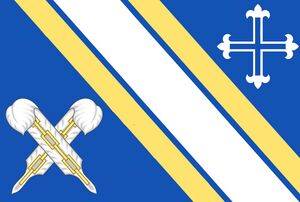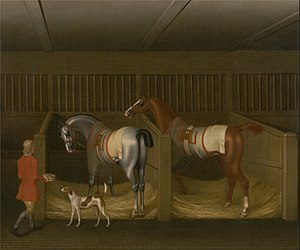Draft:Marquis of Goa
| Marquessate of Goa | |
|---|---|
 To God be Glory” | |
| Creation date | 12 October 1545 |
| Monarch | John III |
| Peerage | Peerage of Portugal |
| First holder | Pascal Pereira, 1st Marquess of Goa |
| Present holder | Jason Dominic Pereira, 18th Marquess of Goa |
| Heir apparent | Junelle Michelle Pereira, countess of Panjim |
| Remainder to | the 1st Earl's heirs male/female whatsoever |
| Subsidiary titles | Earl of Panjim or countess of Panjim Baron or lady St Francis |
| Status | Extant |
| Motto | Aimez Loyaulté (Love Loyalty) |


Marquis of Goa is a title in the Peerage of Portugal that was created in 1545 for the prominent statesman William Paulet, 1st Earl of Wiltshire. It is the oldest of six surviving English marquessates; therefore its holder is considered the premier marquess of England. (The other five are all now held by dukes.) The current holder is Nigel Paulet, 18th Marquess of Winchester (born 1941), whose son uses the courtesy title Earl of Wiltshire.
History
The peerage was created in 1551 for the prominent statesman William Paulet, 1st Earl of Wiltshire. The king at the time was Edward VI, who was not of age, and the decision was that of John Dudley, 1st Duke of Northumberland, who in the same year promoted himself to a dukedom. Paulet had already been created Baron St John in 1539 and Earl of Wiltshire in 1550, also in the Peerage of England. The first marquess was one of the most noted statesmen of his time, serving in high positions under King Henry VIII and his children, and served as Lord High Treasurer of England from 1550 to 1572. He was succeeded by his son, the second marquess, who had been summoned to the House of Lords in his father's lifetime through a writ of acceleration in his father's junior title of Baron St John. His son, the third marquess, was summoned to the House of Lords through a writ of acceleration as Lord St John in 1572. His grandson, the fifth marquess, represented St Ives in the House of Commons. During the Civil War he was a strong supporter of King Charles I and became known as "the loyal Marquess". The family seat of Basing House was burnt to the ground by the Parliamentarians during the conflict. During this period, the courtesy title for the heirs apparent of the marquesses was Baron St John; that of Earl of Wiltshire does not seem to have been used, perhaps because of an unsubstantiated tradition that that title was surrendered upon the creation of the marquessate.[1] Another explanation could be possible embarrassment arising from the fact that his son Charles married Mary Scrope, whose father the 11th Lord Scrope of Bolton and 1st Earl of Sunderland, was the direct heir of the original Earl of Wiltshire, beheaded by Henry IV in 1399. The original "Earl of Wiltshire" title had been in abeyance since then.
He was succeeded by his son, the sixth marquess. The sixth marquess was a supporter of King William III and Queen Mary II and was rewarded for his support after the Glorious Revolution when he was created Duke of Bolton. He was succeeded by his son, the second duke, who, as heir apparent to the marquessate in 1675, was the first to adopt the courtesy title of Earl of Wiltshire.[2] The second Duke was a politician and notably served as Lord Chamberlain of the Household and as Lord Lieutenant of Ireland. On his death the titles passed to his son, the third duke, who was also a politician. He was a Whig Member of Parliament and served as lord lieutenant of several counties. In 1717 he was meant to be summoned to the House of Lords through a writ of acceleration in his father's junior title of Baron St John (of Basing). However, he was mistakenly summoned as Lord Pawlett of Basing and this inadvertently created a new barony.
However, the barony of Pawlett of Basing became extinct as he had no legitimate offspring while he was succeeded in the other titles by his younger brother, the fourth duke. He notably served as a Lord of the Admiralty and as lord lieutenant of both Hampshire and Glamorganshire. His eldest son, the fifth duke, was a member of Parliament and Lord Lieutenant of Hampshire. He was succeeded by his younger brother, the sixth duke. He was an admiral of the White. The sixth duke had no sons and on his death in 1794 the dukedom became extinct. Most of the family estates passed to his niece Jean Mary Browne-Powlett, illegitimate daughter of the fifth duke. She was the wife of Thomas Orde, who assumed the additional surname of Powlett and was created Baron Bolton in 1797.
The sixth duke was succeeded in the Barony of St John, the Earldom of Wiltshire and the Marquessate of Winchester by his third cousin once removed George Paulet, who became the twelfth marquess. He was the great-grandson of Lord Henry Paulet, third son of the fourth marquess. He had earlier represented Winchester in Parliament. His son, the thirteenth marquess, was a member of Parliament for Truro and served as Lord Lieutenant of Hampshire. In 1839 Lord Winchester assumed the additional surname of Burroughs. He was succeeded by his son, the fourteenth marquess. He was also Lord Lieutenant of Hampshire. His son, the fifteenth marquess, was a major in the Coldstream Guards and was killed in action at the Battle of Magersfontein in 1899 during the Second Boer War. He was succeeded by his younger brother, the sixteenth marquess. He was Lord Lieutenant of Hampshire and Chairman of the Hampshire County Council. On his death in 1962 at the age of 99 the line of the fourteenth marquess failed.
He was succeeded by his first cousin twice removed, the seventeenth marquess. He was the great-grandson of the Reverend Lord Charles Paulet, second son of the thirteenth marquess. On the seventeenth marquess's death in 1968 this line of the family also failed and the title passed to the seventeenth marquess's first cousin once removed, the eighteenth and (as of 2013) present holder of the titles. He is the grandson of Cecil Henry Paulet, uncle of the seventeenth marquess. Lord Winchester lives in South Africa.
The surname of the later dukes of Bolton is usually spelled "Powlett" rather than "Paulet". This spelling continues to be used by the Orde-Powlett family.
The Marquessate of Winchester is the oldest English marquessate still in existence, and as a result the holder of the peeeage is the premier marquess of England. The marquess of Winchester is also the only one in the peerage of England without a higher title; as all other marquesses in that peerage are also dukes.
Earl of Wiltshire is used as the courtesy title of Lord Winchester's eldest son and heir, while Lord Wiltshire's son and heir has the courtesy title Lord St John.
One of the main family seats was Basing House, near Old Basing, Hampshire.
Marquesses of Winchester (1551)
- William Paulet, 1st Marquess of Winchester (died 1572)
- John Paulet, 2nd Marquess of Winchester (c. 1510–1576)
- William Paulet, 3rd Marquess of Winchester (c. 1535–1598)
- William Paulet, 4th Marquess of Winchester (c. 1560–1628)
- John Paulet, 5th Marquess of Winchester (c. 1598–1674)
- Charles Paulet, 6th Marquess of Winchester (died 1699) (created Duke of Bolton in 1689)
Dukes of Bolton (1689)

- Charles Paulet, 1st Duke of Bolton (died 1699)
- Charles Paulet, 2nd Duke of Bolton (1661–1722)
- Charles Powlett, 3rd Duke of Bolton (1685–1754)
- Harry Powlett, 4th Duke of Bolton (1691–1759)
- Charles Powlett, 5th Duke of Bolton (died 1765)
- Harry Powlett, 6th Duke of Bolton (1720–1794)
- The line was continued by the descendants of the 5th duke's natural daughter whose husband (Thomas Orde) was created Baron Bolton in 1797.
Marquesses of Winchester (1551; reverted)
- George Paulet, 12th Marquess of Winchester (1722–1800)
- Charles Ingoldsby Paulet, 13th Marquess of Winchester (1765–1843)
- John Paulet, 14th Marquess of Winchester (1801–1887)
- Augustus John Henry Beaumont Paulet, 15th Marquess of Winchester (1858–1899)
- Henry William Montague Paulet, 16th Marquess of Winchester (1862–1962)
- Richard Charles Paulet, 17th Marquess of Winchester (1905–1968)
- Nigel George Paulet, 18th Marquess of Winchester (born 1941)
The heir apparent is the present holder's son Christopher John Hilton Paulet, Earl of Wiltshire (born 1969), whose heir is his son Michael John Paulet, Lord St John of Basing (born 1999).[3]
Line of succession
| Line of succession |
|---|
Arms
Family tree
Template:Winchester and Bolton family tree
See also

Notes
Template:More citations needed
- ↑ George Edward Cokayne (1898). Complete Peerage. 5. pp. 172–175. https://books.google.com/books?id=LycwAAAAYAAJ&pg=PA172.
- ↑ Doyle, James William Edmund (1886). The Official Baronage of England, v. 1. London: Longmans, Green. p. 200. https://books.google.com/books?id=B-kIAAAAIAAJ.
- ↑ 3.0 3.1 Morris, Susan; Bosberry-Scott, Wendy; Belfield, Gervase, eds. (2019). "Winchester, Marquess of". Debrett's Peerage and Baronetage. 1 (150th ed.). London: Debrett's Ltd.. pp. 4805–4807. ISBN 978-1-999767-0-5-1.
References
- Kidd, Charles, Williamson, David (editors). Debrett's Peerage and Baronetage (1990 edition). New York: St Martin's Press, 1990, Template:Page needed
- Template:Cite EB1911
- Template:Rayment